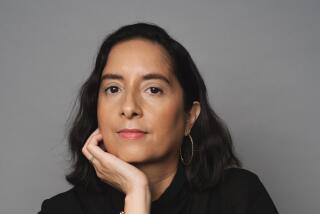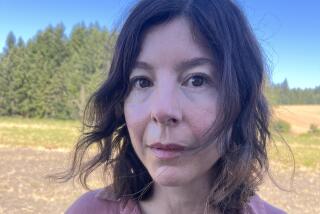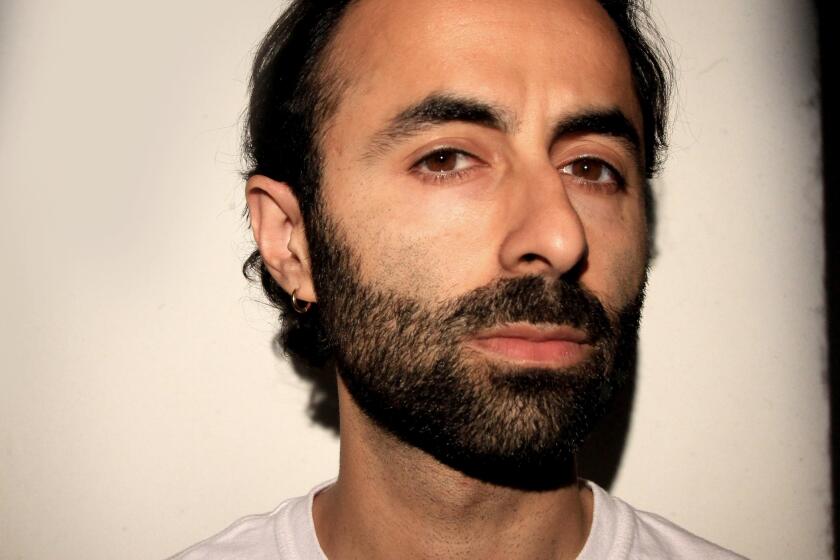Janice Steinberg discusses the Boyle Heights mystery girl in ‘Tin Horse’
Janice Steinberg’s latest creation isn’t technically her creation at all. Rather, the protagonist in her new novel, “The Tin Horse” (Random House: 352 pp., $26 hardcover), is the fully formed version of a marginal character plucked from Raymond Chandler’s “The Big Sleep,” a figure Steinberg had been preoccupied with for a while.
An unnamed young woman who appears for a few brief pages in Chapter 5 of Chandler’s famous noir — she’s in a bookstore, reading a law book, when the detective Philip Marlowe wanders in and asks her about one of the other stores on the street. She is described as a “small dark woman reading a law book at a desk,” who had the “fine-drawn face of an intelligent Jewess.” They exchange some sassy talk, and that’s that. But Steinberg was transfixed.
“There’s a tiny moment when her trajectory and Marlowe’s trajectory intercept,” says Steinberg. “After that, I couldn’t stop hearing her voice in my head.”
Over decaf lattes at a café in Boyle Heights, the Eastside neighborhood where “The Tin Horse” takes place, Steinberg says, “I couldn’t identify with the tough guys who had their first drink at 10 a.m. or the fast women.... But then there’s this nameless character in a three-page scene. This is the one person who might be me. Her repartee with Marlowe is so sharp. I know this woman, and I want to know about her.
“I didn’t have a premise or a story,” says Steinberg, who has written five mystery novels, the last of which was published in 1998. “I just had a person.” What followed was an act of imagination and meticulous research that re-creates a world that Steinberg, 63, had never known.
First came deduction: “She’s Jewish,” says Steinberg. “She lives in L.A. She was reading a law book. She must have been a lawyer, right? Who else reads law books?” “The Big Sleep” had been published in 1939, but Steinberg moved the meeting between the young woman and Philip Marlowe to 1941.
So Steinberg set about learning everything she could about the imaginary young woman and her times, extrapolating details from the few pages of talk and description Chandler provided. She assumed that though the bookstore Marlowe found the young woman in was in Hollywood, if she were Jewish and working class at that time, she would have lived in Boyle Heights.
“I had no idea Boyle Heights existed,” says Steinberg, who lived in Los Angeles in the ‘70s. (She currently lives in San Diego.) The neighborhood has changed a lot since the early part of the 20th century, when Steinberg’s novel is set, but it is still populated by an immigrant population, albeit now a mostly Latino one. As Steinberg walks through the neighborhood, she describes the changes that came when the Interstate Highway plan brought in the 10 Freeway in the 1950s and what it was like before it.
“It was like a utopian experiment that really happened by accident,” she says now of the Boyle Heights of the 1920s and ‘30s, where the Jewish working-class population lived among Japanese and Mexican immigrants. “These were people who couldn’t live in other parts of L.A. There was restrictive housing, or they couldn’t afford it. What they had in common was that they were working people. The neighborhood accepted them.”
Steinberg spent time at the Jewish Historical Society of Southern California listening to audiotapes of testimonials from people raised in Los Angeles in the early part of the 20th century. Some of the stories she heard made it in, but mostly she used them as inspiration for her own stories. “I didn’t want to feel like I was stealing ideas,” she says.
She accumulated six thick folders full of research on dance (the character’s twin was a dancer, and Steinberg herself writes about dance and is certified in Nia, a movement practice), Zionism, food, the economy, worker unions. A historian in Steinberg’s writer’s group in San Diego pointed her toward Harriet Rochlin, whose book “Pioneer Jews” was so helpful that Steinberg named a character in the book after her (Harriet is also the name of Steinberg’s mother).
Steinberg and her husband, a retired computer programmer, took bus tours of Jewish Los Angeles, visiting the school and synagogue Elaine would have attended, including the Breed Street Shul. “More than 1,000 people were going to high holiday services here,” she says, standing in front of the now-decrepit synagogue, which has collapsed steps and a fence around it. There is a building annexed to the side of it, which is where Steinberg will have a reading and book-signing Feb. 24. There is a movement to rehabilitate the building for use again, which harks back to its early days. “It’s not just Jews who want to rebuild this. The Hispanic population wants it to work again, so it can be a community center.”
Finally, after months of research, Steinberg’s central character was fully formed: an earnest young girl who worked, yes, at a bookstore. Steinberg constructed a life for her, naming her Elaine Greenstein and making her the studious twin sister of a wild child whom much of the plot centers on.
In fact, while this is no traditional mystery, the main question of the story revolves around Elaine’s twin, Barbara: Why did she leave, and where did she go? Much of the action culminates with the scene in the bookstore that Chandler had introduced in “The Big Sleep,” in which Philip Marlowe approaches the Jewish girl. But the relationship between Elaine and Marlowe goes further in Steinberg’s version. There is a flirtation, a few dinners, a surprising sexual proposition, and Elaine even procures his investigative services for help in finding her twin.
And so Elaine joins a literary tradition of characters plucked from others’ works and given their own full lives, from “Rosencrantz and Guildenstern are Dead” to “Ahab’s Wife” to “Pride and Prejudice and Zombies.” Steinberg points out that in a sense, stories belong to all of us once they’re published, and characters, even the smallest ones, deserve their own lives.
“I think of it as midrash,” Steinberg says, referring to the reams of commentary on the Old Testament, breakaway stories based on minor characters. “I’ve always been fascinated with small characters, the idea that each person may be a small character in a book, but they all have their own lives.”
Steinberg will be appearing in conversation with Boyle Heights historian George Sanchez at the Breed Street Shul at 2 p.m. Feb. 24. For more info: breedstreetshul.org
Brodesser-Akner is a writer who lives in Los Angeles.
More to Read
Sign up for our Book Club newsletter
Get the latest news, events and more from the Los Angeles Times Book Club, and help us get L.A. reading and talking.
You may occasionally receive promotional content from the Los Angeles Times.








